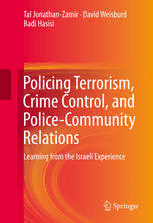
Policing Terrorism, Crime Control, and Police-Community Relations: Learning from the Israeli Experience PDF
Preview Policing Terrorism, Crime Control, and Police-Community Relations: Learning from the Israeli Experience
Tal Jonathan-Zamir · David Weisburd Badi Hasisi Policing Terrorism, Crime Control, and Police-Community Relations Learning from the Israeli Experience Policing Terrorism, Crime Control, and Police-Community Relations Tal Jonathan-Zamir (cid:129) David Weisburd Badi Hasisi Policing Terrorism, Crime Control, and Police-Community Relations Learning from the Israeli Experience Tal Jonathan-Zamir David Weisburd Institute of Criminology, Faculty of Law Institute of Criminology, Faculty of Law Hebrew University of Jerusalem Hebrew University of Jerusalem Mount Scopus Mount Scopus Jerusalem , Israel Jerusalem , Israel Department of Criminology, Badi Hasisi Law and Society Institute of Criminology, Faculty of Law George Mason University Hebrew University of Jerusalem Fairfax , VA , USA Mount Scopus Jerusalem , Israel ISBN 978-3-319-08125-0 ISBN 978-3-319-08126-7 (eBook) DOI 10.1007/978-3-319-08126-7 Springer Cham Heidelberg New York Dordrecht London Library of Congress Control Number: 2014944312 © Springer International Publishing Switzerland 2014 T his work is subject to copyright. All rights are reserved by the Publisher, whether the whole or part of the material is concerned, specifi cally the rights of translation, reprinting, reuse of illustrations, recitation, broadcasting, reproduction on microfi lms or in any other physical way, and transmission or information storage and retrieval, electronic adaptation, computer software, or by similar or dissimilar methodology now known or hereafter developed. Exempted from this legal reservation are brief excerpts in connection with reviews or scholarly analysis or material supplied specifi cally for the purpose of being entered and executed on a computer system, for exclusive use by the purchaser of the work. Duplication of this publication or parts thereof is permitted only under the provisions of the Copyright Law of the Publisher’s location, in its current version, and permission for use must always be obtained from Springer. Permissions for use may be obtained through RightsLink at the Copyright Clearance Center. Violations are liable to prosecution under the respective Copyright Law. T he use of general descriptive names, registered names, trademarks, service marks, etc. in this publication does not imply, even in the absence of a specifi c statement, that such names are exempt from the relevant protective laws and regulations and therefore free for general use. While the advice and information in this book are believed to be true and accurate at the date of publication, neither the authors nor the editors nor the publisher can accept any legal responsibility for any errors or omissions that may be made. The publisher makes no warranty, express or implied, with respect to the material contained herein. Printed on acid-free paper Springer is part of Springer Science+Business Media (www.springer.com) Tal Jonathan-Zamir: To my father, Aharon (Roni) Jonathan (1944–2012), who would have been so very proud to see this book. David Weisburd: For my fathers, Walter and Charles, who passed on to me a love of scholarship. Badi Hasisi: To my beloved family, Rada, Ram, and Mira. Acknowl edgements This study was supported by the Science and Technology directorate of the U.S. Department of Homeland Security under Grant Award Numbers N00140510629 and 2008-ST-061-ST0004, made to the National Consortium for the Study of Terrorism and Responses to Terrorism (START, w ww.start.umd.edu ) , and by the U.S. National Institute of Justice under Grant Number Z909601. The views and conclusions contained in this document are those of the authors and should not be interpreted as necessarily representing the offi cial policies, either expressed or implied, of the U.S. Department of Homeland Security, START, or the National Institute of Justice. vii Contents 1 Introduction and Study Context .............................................................. 1 What Are the Potential Consequences of Policing Terrorism? ................... 4 The Potential Effects of Policing Terrorism on the Crime- Fighting Role of the Police ............................................... 4 The Potential Effects of Policing Terrorism on Police- Community Relationships ...................................................... 6 The Israeli Context for Studying the Outcomes of Policing Terrorism ...... 9 The INP and the Israeli Model for Policing Terrorism ............................... 12 Origins and Structure of the INP ............................................................ 12 The Israeli Model for Policing Terrorism ............................................... 14 Research Questions and Data ...................................................................... 22 References ................................................................................................... 26 2 Terrorist Threats and Police Performance ............................................. 33 Clearance Rates and Police Performance ................................................... 34 The Effects of Policing Terrorism on Clearance Rates: A Study of Israeli Communities ................................................................. 35 Control Variables ..................................................................................... 39 The Findings ............................................................................................... 41 Discussion ................................................................................................... 44 Conclusions ................................................................................................. 47 Appendix 1: Categories of Threat Variables at the Station Level ............... 48 Appendix 2: Regression Without the SES Variable .................................... 48 References ................................................................................................... 49 3 Police Involvement in Counterterrorism and Public Attitudes Toward the Police ...................................................................................... 53 Hypothesis 1: Policing Terrorism May Weaken Public Perceptions of the Police ............................................................................. 54 Hypothesis 2: Policing Terrorism May Encourage Positive Public Evaluations....................................................................................... 55 Policing Terrorism and the “Rally Effect” .................................................. 57 ix
